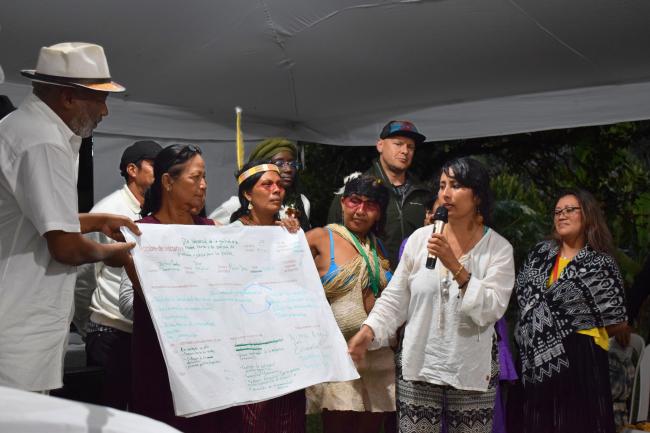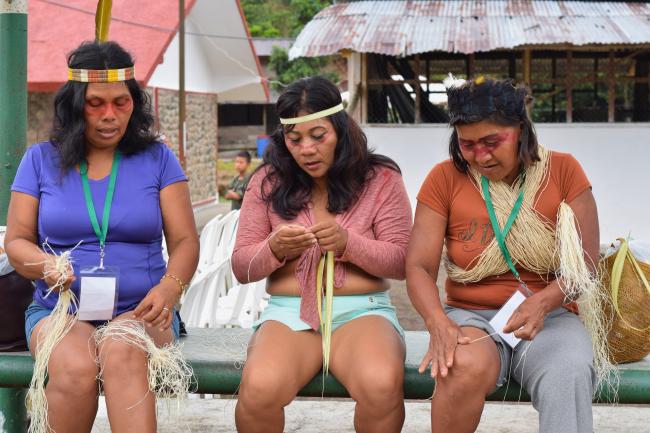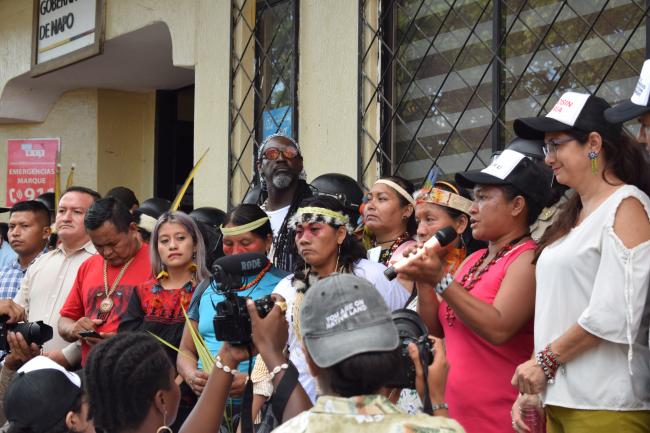
“Yes, we’re here to have fun, but that’s not all. We’re also here to expose our struggles internationally,” says Nelly Shiguango, the women’s leader of the Federation of Indigenous Organizations of Napo Province in the Ecuadorian Amazon. “We want you to see how our forests are being destroyed, how our life is being destroyed, how our rivers are disappearing.”
Nelly is leading a group of Indigenous and Afrodescendant activists down the Jatunyacu River on one of the exhilarating rafting trips the waterway is famous for. The Jatunyacu is one of the main tributaries of the Amazon, originating at a glacier fed by the Cotopaxi Volcano. Yellow-tailed yapú birds glide across the water, returning to their low-hanging basket nests, and giant blue morpho butterflies explore its shores.
Since the Covid-19 pandemic, rafting has also become a stark way to spot the hundreds of legal and illegal gold mining sites choking the river and the majority Kichwa Indigenous communities whose livelihoods depend on it.
Activists from 22 countries representing Indigenous and Afrodescendant organizations and media collectives traveled from their territories—spanning Suriname, Colombia, Trinidad and Tobago, Uruguay, Argentina, Haiti, the Dominican Republic, and more—to attend an urgent meeting last month in response to the dangerous rise in illegal mining in the Napo province and across the region. They were invited by Leo Cerda, a local community leader and co-founder of the Americas-wide Black and Indigenous Liberation Movement (BILM), to create a coalition. “A movement is built by many, not by one. We need to start thinking about local strategies with a global impact,” Leo explains in an interview.
Arriving first to Quito on a warm October morning, the delegates then dropped over 2,000 meters in altitude to Tena, a small city at the gateway to the Amazon, before entering Talag land in a convoy of buses. Crossing the Jatunyacu via one of its wobbly metal bridges, the attendees were met by a sign stating “The Kichwa community of Serena says: No to mining! We exercise our right to self-determination.”
The group arrives in plain sight, letting the miners know that all eyes are on Serena.
Overlapping Security and Environmental Crises
The recent spike in violent crime in Ecuador dominated this year’s turbulent general elections, which saw anti-corruption candidate Fernando Villavencio assassinated in the streets of Quito just days before the first round of voting. Surprise center-right winner Daniel Noboa, heir to a banana empire, has pledged to tackle the security crisis as the central focus of his truncated 18-month presidency, with plans to roll out the military across port towns and hold a popular consultation on the issue within the first 100 days of his mandate.
But narcotrafficking groups have gained a deeper foothold in Ecuador and the wider region, and are now present in 69.5 percent of the Amazon border municipalities of Bolivia, Brazil, Colombia, Ecuador, Peru, and Venezuela. With gold prices at an all-time high, criminal groups are increasingly turning to gold mining to fund their illicit activity, with illegal mining operations rapidly expanding across the Amazon.
The Ecuadorian Amazon has emerged as a battleground. Its riverbanks have been devastated by both legal and illegal gold mining, with 152 legal mining concessions registered in Leo’s Napo province alone by 2020. Mining exports increased by 86 percent between 2008 and 2018, positioning gold as Ecuador’s fourth most important export. This paved the way for illegal mining, and by 2016 over three-quarters of Ecuador’s gold was extracted illegally, mainly from the Amazon. When the pandemic began, these numbers spiked further. In May 2023, the Interior Ministry identified illegal mining camps in 21 of the country’s 24 provinces.
In some areas like Yutzupino, downstream from Serena, river channels have been completely rerouted due to mining. Smaller tributaries of the Napo River have been obliterated, ravaging biodiversity and contaminating or eliminating water sources for local communities.
“They leave our forests destroyed, our river destroyed, our way of life destroyed. How are we going to live? We depend on the water. We live from the river,” says Leo.
This is not the only reason Ecuador is well-suited to host the BILM Anti-Mining Camp. The country has made headlines globally for the recent environmental referendum on extractivism, the first of its kind worldwide, in which citizens voted to halt oil drilling in Yasuní National Park in the Amazon and prohibit mining in the Chocó Andino region in the Andes. These victories indicate that Ecuadorians are listening to the calls of activists and Indigenous peoples to end the country’s half-century reliance on oil and extractive business. The referendum has opened up a rare opportunity for grassroots groups to push forward anti-extractivist agendas, making this gathering of activists more important and timelier than ever.
Anti-mining Camp in Serena
The week-long anti-mining camp convened by the BILM team was divided into two branches: the second BILM Congress, designed to foment solidarity between Indigenous and Afrodescendant communities and develop critical strategies to curb mining; and the first-ever BILM climate storytelling lab, hosted by the British Film Institute’s Doc Society to strengthen community and grassroots media skills.

“We’re here in solidarity, but also to strategize and create our own narratives against extractivism,” Leo states in his opening speech. “We are here to demand climate justice, racial justice. And the theme of this camp is mining, because we want to create a strategy and alliances to fight this issue as a whole. The problem is not only local, it is regional.”
The activists gather strength each morning with sacred wayusa herbal water, tobacco dripped through the nose for cleansing, fermented plantain chicha for stomach health, and a nourishing breakfast. The meals are led by Yuturi Warmi, the first women-led Territorial Guard in Ecuador, fronted by Kichwa women from Serena. Their name is inspired by the peaceful fire ant, who, when her territory is threatened, defends with her bite. Yuturi Warmi keeps watch over the 800 to 1000 hectare territory, and boosts the local economy through handicrafts and tourism initiatives that they hope will persuade their neighbors to turn away from illegal mining and avoid the deep community divisions it can create. Their crafts are sold internationally under the community-led fashion label Hakhu Amazon Design.
Lucía Ixchíu, an Indigenous coordinator with the Movement, thanks the women of Yuturi Warmi, who produce for the delegates flawless meals of fresh tilapia, mashed yucca and plantains, and grilled chontacuro bugs from the rainforest. “It remains the pueblos, the women,” she says, “who sustain and nourish resistance.”
Concrete Solutions
BILM’s integral belief is that there can be no climate justice without racial justice. Fittingly, the Congress tackles three focus areas: racial justice, climate justice, and anti-extractivism, with sub-committees that brainstorm strategies for each strand. The ambitious proposals are built around the need to take back control of vital territories—directly, where mining activity has encroached on community and public land, and indirectly, in terms of research, schooling, and justice.
The cross-cultural teams of activists stress the need to form regional research groups made up of sociologists, anthropologists, social scientists, and ecologists. These cross-disciplinary groups will gather information on new monitoring technologies, effective sanctions, and alternative understandings of justice, and will strategize how to see them written into policy. Research teams in each community are to design “planes de vida,” or plans for life, to delineate the needs of communities to NGOs that are positioned to respond and support them. This will encourage international organizations to funnel project money directly to communities rather than via NGOs working in the country. The teams are also commissioned with building the content for courses to be taught at intergenerational training centers to be established in each territory as part of the regional BILM School.
BILM School trainings, currently offered virtually, are designed to cover anti-extractivism theory, anti-mining tactics, identity politics, multimedia storytelling, and ancestral knowledge with specific courses in literary traditions, for example, to challenge hegemonic narratives of colonial literature that have led to the loss of oral traditions. In community-based learning centers and online spaces, participants will learn about their rights and the rights of nature, as enshrined in the UN-sponsored regional Ezcazú Agreement.
The biggest proposal to come out of the gathering is the International Court of Climate Justice, which BILM organizations hope to establish in order to identify, judge, condemn, and demand reparations from extractivist corporations across the Americas. It would function as an alternative court, separate from national juridical institutions, and would apply legal pluralism through a council of elders from diverse cultures. “We are fighting mega corporations who function on a transnational level, so why not create resistance strategies on a transterritorial level?” Lucía asks in reference to the proposal. At present, the idea is just a seed.
The teams also conceive of strategies for immediate implementation, like establishing territorial guards inspired by Yuturi Warmi who not only oversee security measures but also promote unity, safeguard culture, and boost the local economy. They encourage representatives to declare their territories free from mining through signage and media. Sustainable community-led tourism is underscored as a key source of income, proving to authorities that “new markets” do not need to rest exclusively on extractivism, and demonstrating to locals that they don’t have to turn to mining for income.

Juanita Francis Bone, director of Mujeres de Asfalto, a women’s collective in Esmeraldas on the Ecuadorian coast, tells the delegates: “Taking a step back from the discourse and really looking at practical solutions allowed us to recognize the difficulties each of us faces. Not to bury ourselves in hopelessness, but to accompany one another in our struggles.”
Lucía invites difference and debate as a key part of the collective process: “The Congress is a very ambitious initiative… it’s been intense,” she says. This gathering of diverse groups is also a stage for disagreements and debates, different conceptions of history and identity, and different ways of being in the world, bringing varying experiences of trauma into one collective space. Lucía notes that “this exchange of experiences is vital for the creation of collective strategies.”
“Many of the communities who are facing problems here in the Amazon think they are facing these problems alone,” Leo explains. “I think seeing all these people that are facing similar experiences makes us stronger because we unite.”
Rosa Gaba, a Waorani woman, echoes Leo: “We are here to find protection and to fight for our territories and their conservation hand-in-hand with our brothers and sisters.” Rosa traveled over six hours from Yasuní National Park, alongside her compañeras, to join the congress. They’ve brought with them songs, dance, handicrafts, sustainable clothing, and a fierce anti-extraction message.
Climate Storytelling and The Power of Narrative
Waorani and Kichwa communities fight side-by-side to expel extractivism from their forests. Youth from both groups have been collaborating on audiovisual material to support their campaigns through the production company Mullu TV and the Hahku Amazon Foundation. Weya Alicia Cahuiya, a Waorani leader, explains that “BILM builds capacity among our youth so that they can run our own communications and share our stories with the rest of the world.”
The work of strategic storytelling was essential in convincing voters to keep oil in the ground as part of the #SíAlYasuní campaign. “Here in Ecuador, most of the people on the coast haven’t been to the Amazon. So we brought the Amazon to them,” Leo explains of the campaign.
Weya shares how she and fellow Waorani women traveled in caravans from Yasuní to the Sierra, along the coast, and down to the southern Ecuadorian Amazon, “walking, singing, spreading our message, explaining why we wanted people to vote Yes for Yasuní, counting more women, more brothers and sisters in our fight.”
President-elect Daniel Noboa, who took office on November 23, will have the final word on the status of the two oil blocks in Yasuní. He has said he will respect the will of voters. In November, the CEO of Ecuador’s state oil company Petroecuador said it plans to gradually close a large drilling project in Yasuní beginning next August. Time will tell, and local groups like Napo Ama La Vida and Napo Resiste will continue to denounce illegal extractivism in their territories, alerting local authorities through videos and media.
Communications and intelligence sharing constitute key tools for these communities, alongside technical data, research, and legal support. To harness this potential, a program of Climate Story Lab workshops is offered alongside the BILM congress, led by the global documentary filmmaking non-profit Doc Society. The workshops explore what narratives are most needed and most effective for addressing the climate crisis, with a focus on journalism, podcasting, and film.
The Doc Society has expertise on the impacts of Indigenous storytelling. They produced the impact campaign for the National Geographic film The Territory, which increased Indigenous protagonism in environmental politics and in filmmaking in Brazil. The Doc Society team provided the Indigenous Uru Eu Wau Wau territorial guard with GoPro cameras so they could better document invasions into their territory in the Brazilian Amazon. A screening of the film in Brussels to members of the European Parliament led to the passage of the Anti-Deforestation Law in December 2022, which requires companies trading commodities in the EU market to ensure their goods are not linked to recent deforestation, forest degradation, or breaches of local environmental laws.
On the closing night, short films are presented on identity and resistance, including the Caribbean Freedom Project’s “No Pride in Genocide.” Sustainable fashion from Hakhu Amazon Design is showcased by BILM members representing different cultures, followed by traditional dance and then live music from the Esmeraldan hip-hop singer Black Mama and the Brazilian DJ Eric Terena.

Black and Indigenous Liberation Day
The camp is a roaring success: cross-border connections are built between activists fighting similar processes of dispossession and insecurity. Serena’s capacity for tourism is bolstered through hosting this week of activities. “I feel so honored to have people visit my territory, and I think that it really empowers my community,” Leo remarks. A wealth of content is created and shared, catapulting international visibility of the mining emergency in Napo and beyond.
The camp culminates in a passionate march through Tena on 12 October. Widely celebrated as “Columbus Day” marking the “discovery of the Americas,” here the date is reclaimed as Black and Indigenous Liberation Day. Some delegates march in traditional dress with strategic messages like “Why do we destroy what keeps us alive?” Members of youth rafting tour company holds up their oars in resistance. “Fuerza fuerza, guardia guardia!” can be heard roaring through the streets, Yuturi Warmi’s signature call and response.
“This is a day of remembrance. This is a day of movement building,” Leo stresses.
While the stakes are daunting and extractive capitalism will not be dismantled through one gathering of activists and allies, the collective strength drawn from these experiences and injustices is palpable. It is rare to witness a space where each voice is heard and harnessed to create concrete goals that address intersectional struggles. These groups know what they are capable of, especially in international alliance, and witnessing them work together offers a rare glimmer of hope for the future of humanity. As Christio Wijnhard from Suriname told us, “I think what I saw here is the way humans should be.”
Rebecca Wilson is a journalist and translator based in Bogota, Colombia. She is Managing Editor at the Latin America Bureau, which has reported on social and environmental issues in Latin America since the 1970s.
Eliana Lafone is a British-Uruguayan documentary filmmaker and journalist based in Colombia. Her work focuses on human rights, mining and the environment, and she has worked for outlets and NGOs including: BBC, Channel 4, WWF, Red Muqui, Children Change Colombia.
This post was originally published on this site be sure to check out more of their content.








